Numerical Simulation of Water Based Ferrofluid Flows along Moving Surfaces
Abstract
:1. Introduction
2. Formulation of the Problem
3. Results and Discussion
4. Conclusions
Author Contributions
Funding
Acknowledgments
Conflicts of Interest
References
- Choi, S. Enhancing thermal conductivity of fluids with nanoparticles. Dev. Appl. Non-Newton. Flows 1995, 231, 99–105. [Google Scholar]
- Godson, L.; Raja, B.; Lal, D.M.; Wongwises, S. Enhancement of heat transfer using nanofluids—An overview. Renew. Sustain. Energy Rev. 2010, 14, 629–641. [Google Scholar] [CrossRef]
- Saidur, R.; Leong, K.Y.; Mohammad, H.A. A review on applications and challenges of nanofluids. Renew. Sustain. Energy Rev. 2011, 15, 1646–1668. [Google Scholar] [CrossRef]
- Sivashanmugam, P. Application of nanofluids in heat transfer. In An Overview of Heat Transfer; Kazi, S.N., Ed.; INTECH Publications: Reijka, Croatia, 2012; Chapter 14; pp. 411–440. [Google Scholar] [CrossRef] [Green Version]
- Neuringer, J.L.; Rosensweig, R.E. Ferrohydrodynamics. Phys. Fluids 1964, 7, 1927–1937. [Google Scholar] [CrossRef]
- Rosensweig, R.E. Magnetic fluids. Annu. Rev. Fluid Mech. 1987, 19, 437–463. [Google Scholar] [CrossRef]
- Akbarzadeh, A.; Samiei, M.; Davaran, S. Magnetic nanoparticles: Preparation, physical properties, and applications in biomedicine. Nanoscale Res. Lett. 2012, 7, 144. [Google Scholar] [CrossRef] [PubMed] [Green Version]
- Singamaneni, S.; Bliznyuk, V.N.; Binek, C.; Tsymbal, E.Y. Magnetic nanoparticles: Recent advances in synthesis, self-assembly and applications. J. Mater. Chem. 2011, 21, 16819–16845. [Google Scholar] [CrossRef] [Green Version]
- Frey, N.A.; Peng, S.; Cheng, K.; Sun, S. Magnetic nanoparticles: Synthesis, functionalization, and applications in bioimaging and magnetic energy storage. Chem. Soc. Rev. 2009, 38, 2532–2542. [Google Scholar] [CrossRef]
- Cabuil, V. Dekker Encyclopedia of Nanoscience and Nanotechnology; Chapter 119 Magnetic Nanoparticles: Preparation and Properties. Roldan Group Puplications; CRC Press: Boca Raton, FL, USA, 2004. [Google Scholar]
- Sheikholeslami, M.; Rashidi, M.M. Effect of space dependent magnetic field on free convection of Fe3O4–water nanofluid. J. Taiwan Inst. Chem. Eng. 2015, 56, 6–15. [Google Scholar] [CrossRef]
- Haq, R.U.; Noor, N.F.M.; Khan, Z.H. Numerical simulation of water based magnetite nanoparticles between two parallel disks. Adv. Powder Technol. 2016, 4, 1568–1575. [Google Scholar] [CrossRef]
- Ghosh, D.; Gupta, T.; Sahu, R.P.; Das, P.K.; Puri, I.K. Three-dimensional printing of diamagnetic microparticles in paramagnetic and diamagnetic media. Phys. Fluids 2020, 32, 072001. [Google Scholar] [CrossRef]
- Kefeni, K.K.; Msagati, T.A.M.; Mamba, B.B. Ferrite nanoparticles: Synthesis, characterisation and applications in electronic device. Mater. Sci. Eng. B 2017, 215, 37–55. [Google Scholar] [CrossRef]
- Brar, S.K.; Verma, M.; Tyagi, R.D.; Surampalli, R.Y. Engineered nanoparticles in wastewater and wastewater sludge—Evidence and impacts. Waste Manag. 2010, 30, 504–520. [Google Scholar] [CrossRef]
- Thakura, P.; Chahara, D.; Tanejaa, S.; Bhallabd, N.; Thakur, A. A review on MnZn ferrites: Synthesis, characterization and applications. Ceram. Int. 2020, 46, 15740–15763. [Google Scholar] [CrossRef]
- Prandtl, L. Uber Flussigkeitsbewegungen bei sehr kleiner Reibung. Verhanglg. III. Intern. Math. Kongr. Heidelberg. 1904, 484–491. [Google Scholar] [CrossRef]
- Sakiadis, B.C. Boundary-layer behavior on continuous solid surfaces: I. Boundary-layer equations for two-dimensional and axisymmetric flow. Aiche J. 1961, 7, 26–28. [Google Scholar] [CrossRef]
- Sakiadis, B.C. Boundary-layer behavior on continuous solid surfaces: II. The boundary layer on a continuous flat surface. Aiche J. 1961, 7, 221–225. [Google Scholar] [CrossRef]
- Tsou, F.K.; Sparrow, E.M.; Goldstein, R.J. Flow and heat transfer in the boundary layer on a continuous moving surface. Int. J. Heat Mass Transf. 1967, 10, 219–235. [Google Scholar] [CrossRef]
- Crane, L.J. Flow past stretching plate. Z. Angew. Math. Phys. 1970, 21, 645–647. [Google Scholar] [CrossRef]
- Chakrabarti, A.; Gupta, A.S. Hydromagnetic flow and heat transfer over a stretching sheet. Q. Appl. Math. 1979, 37, 73–78. [Google Scholar] [CrossRef] [Green Version]
- Banks, W.H.H. Similarity solutions of the boundary layer equations for a stretching wall. J. Mécan. Théor. Appl. 1983, 2, 375–392. [Google Scholar]
- Bognár, G. On similarity solutions of boundary layer problems with upstream moving wall in non-Newtonian power-law fluids. IMA J. Appl. Math. 2012, 77, 546–562. [Google Scholar] [CrossRef]
- Bognár, G.; Csáti, Z. Numerical solution to boundary layer problems over moving flat plate in non-Newtonian media. J. Appl. Math. Phys. 2014, 2, 8–13. [Google Scholar] [CrossRef] [Green Version]
- Bognár, G. Numerical method for the boundary layer problems of non-Newtonian fluid flows along moving surfaces. Electron. J. Qual. Theory Differ. Equ. 2016, 2016. [Google Scholar] [CrossRef]
- Chiam, T.C. Hydromagnetic flow over a surface stretching with a power-law velocity. Int. J. Eng. Sci. 1995, 33, 429–435. [Google Scholar] [CrossRef]
- Andersson, H.I.; Aarseth, J.B. Sakiadis flow with variable fluid properties revisited. Int. J. Eng. Sci. 2007, 45, 554–561. [Google Scholar] [CrossRef]
- Takhar, H.S.; Nitu, S.; Pop, I. Boundary layer flow due to a moving plate: Variable fluid properties. Acta Mech. 1991, 90, 37–42. [Google Scholar] [CrossRef]
- Pop, I.; Gorla, R.S.R.; Rashidi, M. The effect of variable viscosity on the flow and heat transfer to a continuous moving flat plate. Int. J. Eng. Sci. 1992, 30, 1–6. [Google Scholar] [CrossRef]
- Elbashbeshy, E.M.A.; Bazid, M.A.A. The effect of temperature-dependent viscosity on heat transfer over a continuous moving surface. J. Phys. A Appl. Phys. 2000, 33, 2716–2721. [Google Scholar] [CrossRef]
- Mahabaleshwar, U.S.; Kumar, P.N.V.; Nagaraju, K.R.; Bognár, G.; Nayakar, S.N.R. A new exact solution for the flow of a fluid through porous media for a variety of boundary conditions. Fluids 2019, 4, 125. [Google Scholar] [CrossRef] [Green Version]
- Andersson, H.I. MHD flow of a viscoelastic fluid past a stretching surface. Acta Mech. 1992, 95, 227–230. [Google Scholar] [CrossRef]
- Siddheshwar, P.G.; Mahabaleshwar, U.S.; Chan, A. MHD flow of Walters’ liquid B over a nonlinearly stretching sheet. Int. J. Appl. Mech. Eng. 2015, 20, 589–603. [Google Scholar] [CrossRef] [Green Version]
- Singh, J.; Mahabaleshwar, U.S.; Bognár, G. Mass transpiration in nonlinear MHD flow due to porous stretching sheet. Sci. Rep. 2019, 9, 1–15. [Google Scholar] [CrossRef] [PubMed] [Green Version]
- Ullah, I.; Shafie, S.; Khan, I. Effects of slip condition and Newtonian heating on MHD flow of Casson fluid over a nonlinearly stretching sheet saturated in a porous medium. J. King Saud Univ. Sci. 2017, 29, 250–259. [Google Scholar] [CrossRef] [Green Version]
- Andersson, H.I.; Valnes, O.A. Flow of a heated ferrofluid over a stretching sheet in the presence of a magnetic dipole. Acta Mech. 1998, 128, 39–47. [Google Scholar] [CrossRef]
- Neuringer, J.L. Some viscous flows of a saturated ferro-fluid under the combined influence of thermal and magnetic field gradients. Int. J. Non-Linear Mech. 1966, 1, 123–137. [Google Scholar] [CrossRef]
- Khan, W.A.; Khan, Z.H.; Haq, R.U. Flow and heat transfer of ferrofluids over a flat plate with uniform heat flux. Eur. Phys. J. Plus 2015, 130, 86. [Google Scholar] [CrossRef]
- Bognár, G.; Hriczó, K.; Stojanović, B.; Szávai, S. Ferrofluid flow in the presence of magnetic field above stretching sheet. Tribol. Ind. 2019, 41, 426–432. [Google Scholar] [CrossRef]
- Bognár, G.; Hriczó, K. Ferrofluid flow in magnetic field above stretching sheet with suction and injection. Math. Model. Anal. 2020, 25, 461–472. [Google Scholar] [CrossRef]
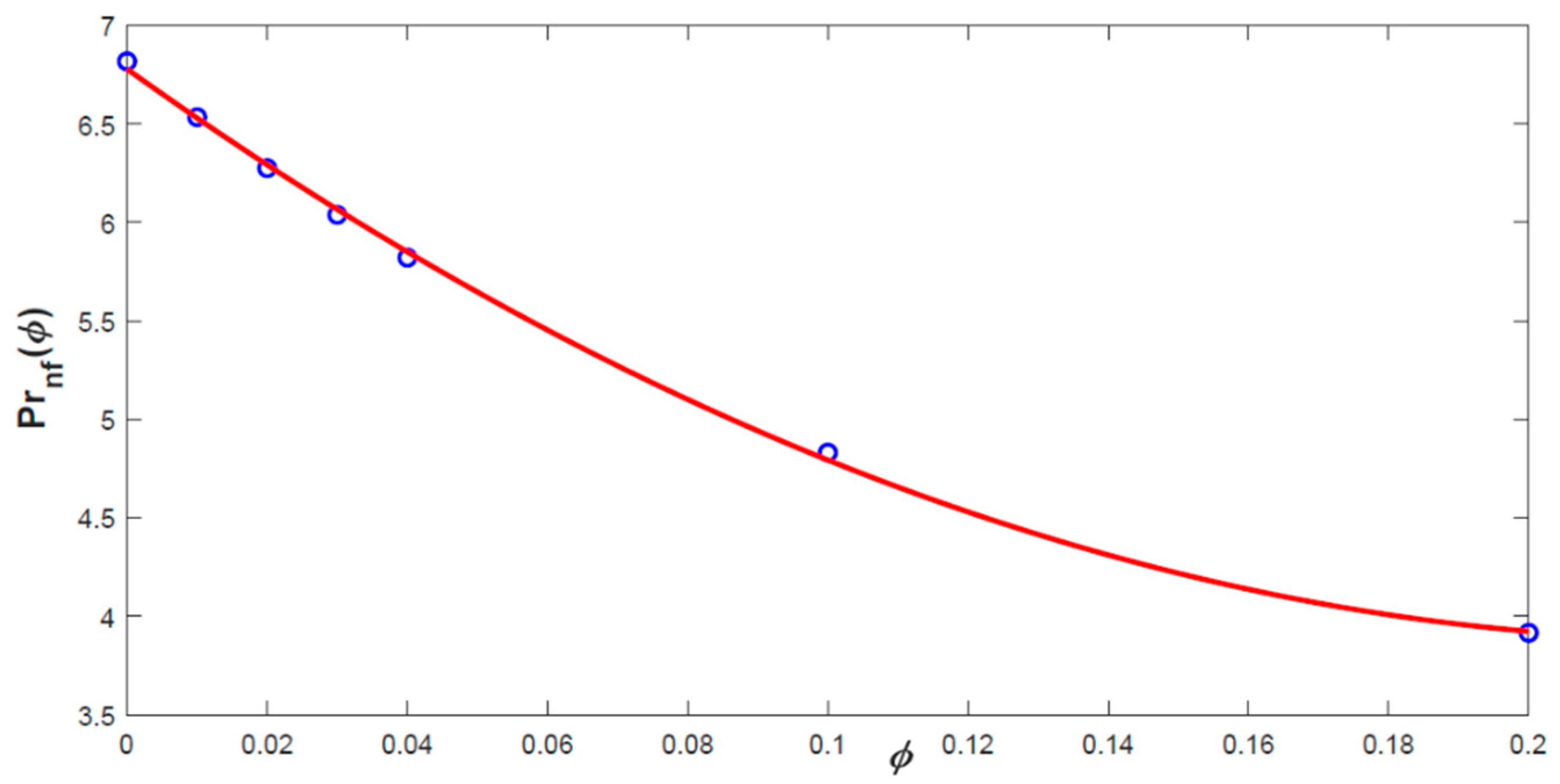


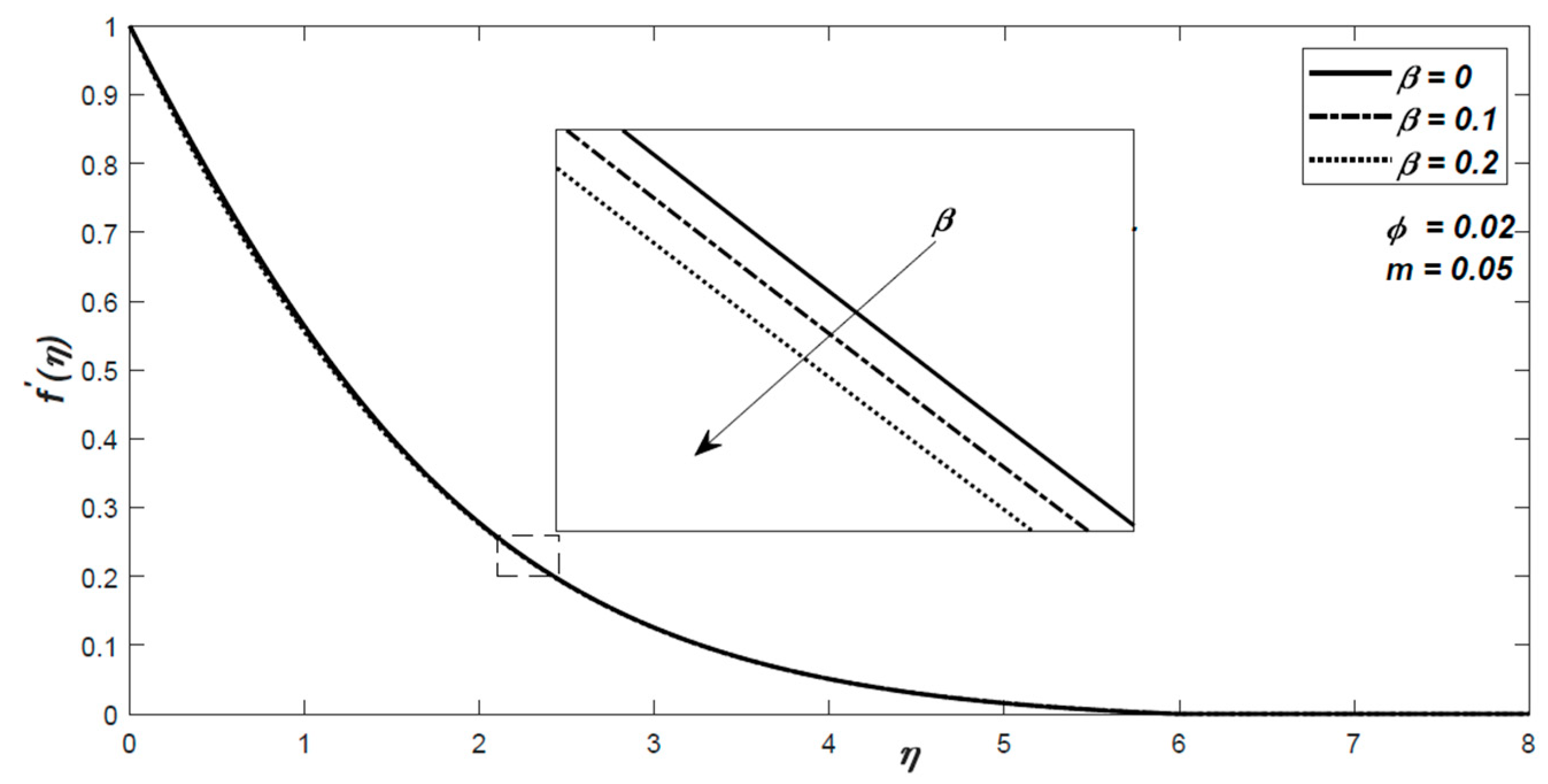


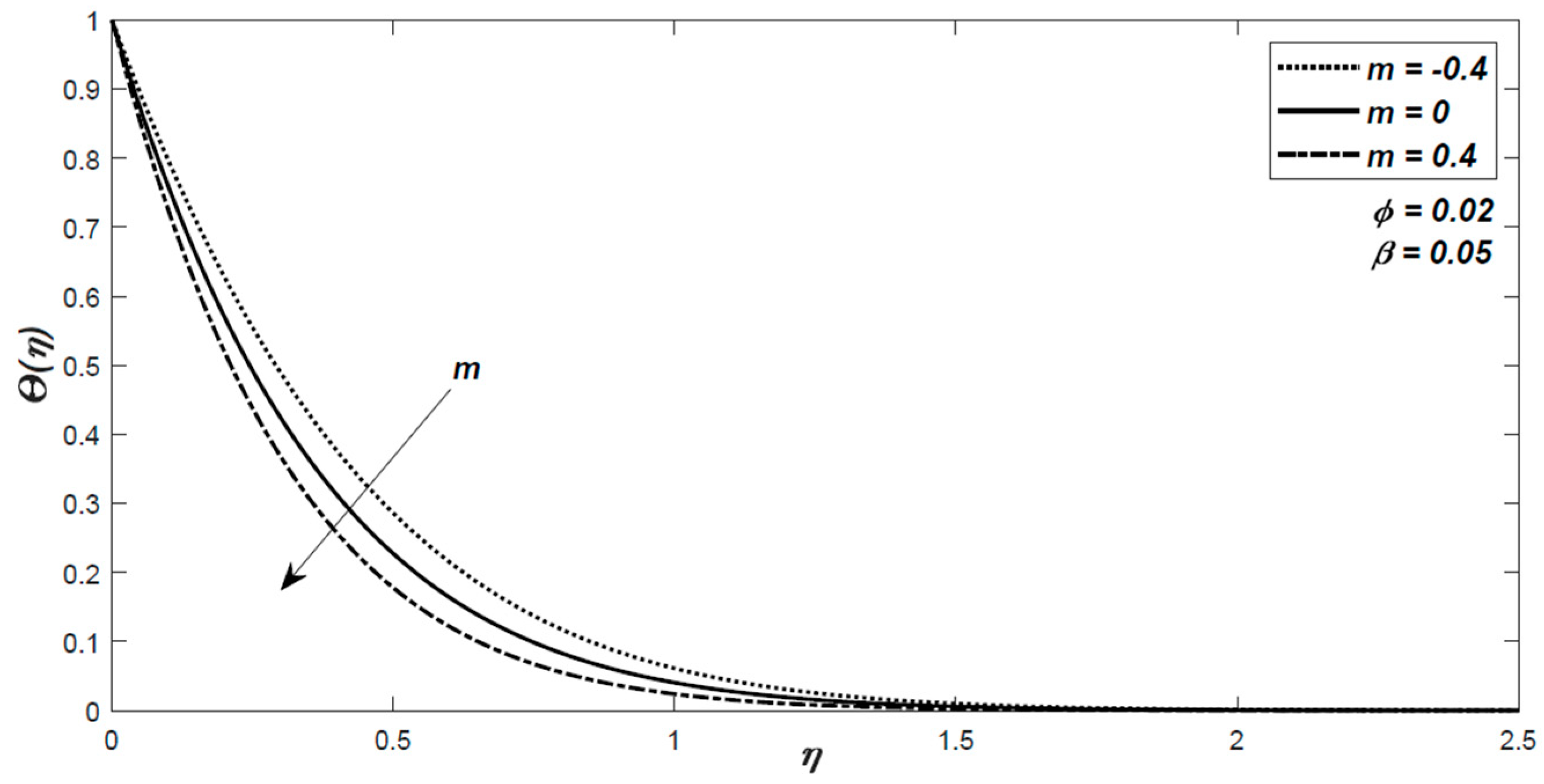
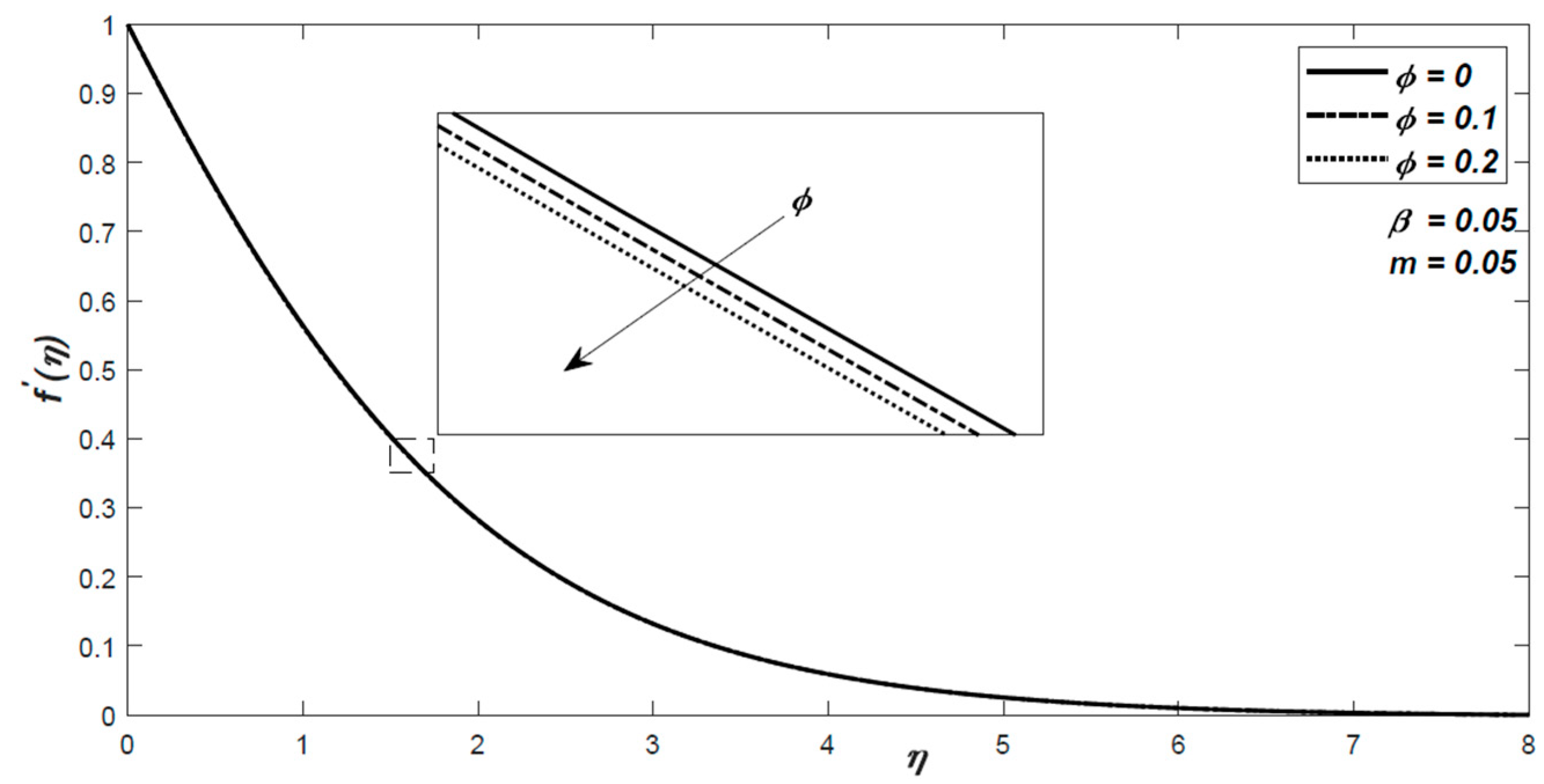

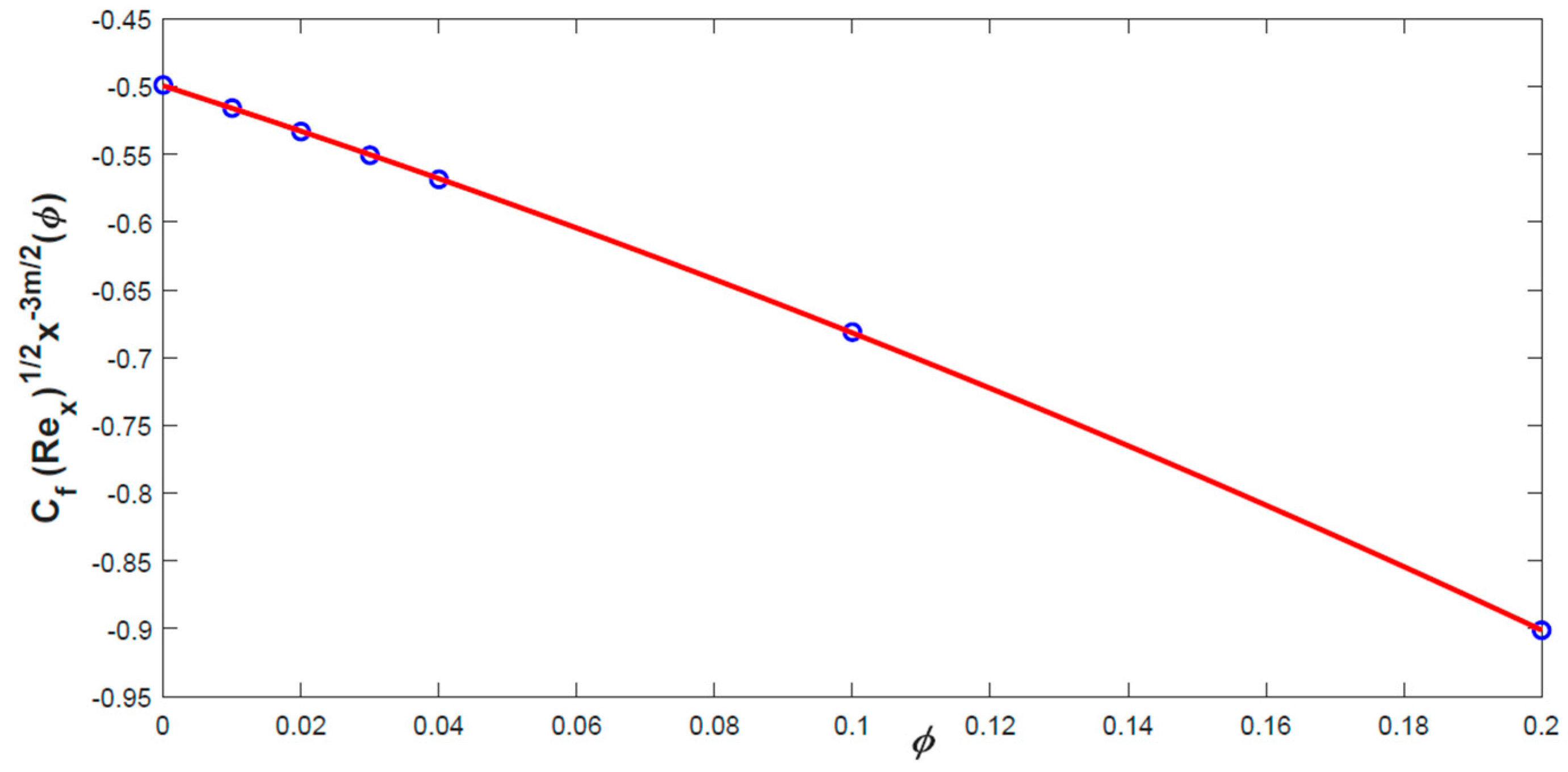

| Parameter | Fe3O4 | CoFe2O4 | Mn-ZnFe2O4 | H2O |
|---|---|---|---|---|
| 5180 | 4907 | 4900 | 997.1 | |
| 670 | 700 | 800 | 4179 | |
| k | 9.7 | 3.7 | 5 | 0.613 |
| - | - | - | 0.001 |
| 0 | 0.49878 | 2.88860 |
| 0.01 | 0.49905 | 2.82487 |
| 0.02 | 0.49931 | 2.76548 |
| 0.03 | 0.49957 | 2.71004 |
| 0.04 | 0.49981 | 2.65821 |
| 0.1 | 0.50114 | 2.40859 |
| 0.2 | 0.50279 | 2.15356 |
| 0 | 0.48568 | 2.76777 |
| 0.1 | 0.51299 | 2.76318 |
| 0.2 | 0.54350 | 2.75758 |
| 0.3 | 0.57565 | 2.75144 |
| 0.4 | 0.61388 | 2.74333 |
| −0.4 | −0.19087 | 2.21520 |
| −0.2 | 0.25261 | 2.45502 |
| 0 | 0.45861 | 2.70528 |
| 0.1 | 0.53734 | 2.82465 |
| 0.2 | 0.60697 | 2.93399 |
| 0.3 | 0.69944 | 3.10580 |
| 0.4 | 0.72781 | 3.15931 |
© 2020 by the authors. Licensee MDPI, Basel, Switzerland. This article is an open access article distributed under the terms and conditions of the Creative Commons Attribution (CC BY) license (http://creativecommons.org/licenses/by/4.0/).
Share and Cite
Bognár, G.; Hriczó, K. Numerical Simulation of Water Based Ferrofluid Flows along Moving Surfaces. Processes 2020, 8, 830. https://doi.org/10.3390/pr8070830
Bognár G, Hriczó K. Numerical Simulation of Water Based Ferrofluid Flows along Moving Surfaces. Processes. 2020; 8(7):830. https://doi.org/10.3390/pr8070830
Chicago/Turabian StyleBognár, Gabriella, and Krisztián Hriczó. 2020. "Numerical Simulation of Water Based Ferrofluid Flows along Moving Surfaces" Processes 8, no. 7: 830. https://doi.org/10.3390/pr8070830






